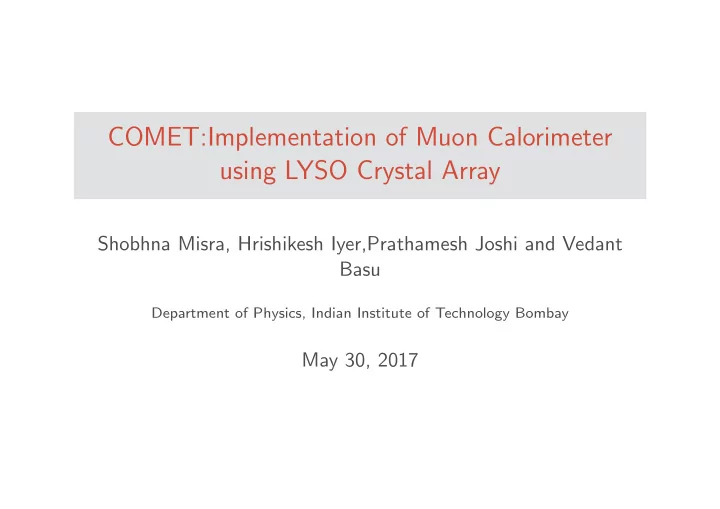

COMET:Implementation of Muon Calorimeter using LYSO Crystal Array Shobhna Misra, Hrishikesh Iyer,Prathamesh Joshi and Vedant Basu Department of Physics, Indian Institute of Technology Bombay May 30, 2017
Outline ◮ Importance ◮ LYSO Calorimeter Overview ◮ Experimental Setup ◮ Procedure ◮ Data Collection ◮ Results
Charged Lepton Flavour Violation ◮ In the minimal Standard Model Framework with massless neutrinos, lepton flavour conservation is a consequence of gauge invariance. However, the phenomenon of neutrino mixing demonstrates flavour violation in leptons ◮ Observation of flavour violation in charged leptons would provide definitive evidence of new physics, being highly suppressed by the Standard Model. ◮ Coherent neutrino-less conversion of a negative muon to an electron ( µ − N → e − N ) in a muonic atom is a prominent and experimentally favourable process,due to a monoenergetic signal electron at energies far from the normal muon decay spectrum
LYSO Calorimeter ◮ Crystal Calorimetry is especially advantageous due to total absorption. This provides accurate energy and position resolution, along with efficient reconstructions ◮ The LYSO (Lithium-Yttrium Oxyorthosilicate) crystal is suitable as a scintillator due to its high density and fast scintillation ◮ An array of Avalanche Photodiodes(Hamamatsu S8664-55). converts this scintillation into a voltage signal, which is then fed into a pre-amplifier. This data is then digitized by EROS boards and fed into the Data Acquisition Unit. ◮ A slow control board is implemented to control calibration LEDs, and monitor Temperature.
Experimental Setup- Trigger ◮ The Level 1 trigger has been implemented using two plastic scintillation detectors ◮ These are separated by an optimal distance to reduce the solid angle, improving trigger efficiency. ◮ The scintillation is converted into a voltage pulse via a Photomultiplier Tube ◮ The two PMT signals are then passed through a threshold discriminator module, followed by a coincidence trigger. This is converted to ECL outputs, which serve as the overall trigger for the EROS board.
Figure 1: Trigger Setup
EROS Board ◮ Upon receiving the trigger, the analog input to the EROS board is passed through the DRS4 IC, which is a high speed Domino Ring Sampler. ◮ The main processing is done by a Xilinx Artix-7 FPGA chip. ◮ To reduce dead time on the electronics, a daisy chain system has been designed to network multiple EROS boards,using the high speed SiTCP protocol.
Figure 2: capacitor offset values
Data Processing ◮ Data Processing was performed on ROOT ◮ We initially calculated capacitor offset voltages using a baseline sample ◮ After compensating for the offset we averaged the baseline over 10000 entries, and subtracted it from the raw signal data.
Results:Linearity The linearity of the output characteristics of the EROS board were tested using an RC Differentiator and a Function Generator Figure 3: Output amplitude v/s input amplitude
Results:Temperature The stability of the output was studied across the operational range of 22 ◦ C − 28 ◦ C Figure 4: Signal maxima vs Temperature
Results: Cosmic Muon Signals Finally, the entire assembly was tuned for detection of Cosmic Ray Muons Figure 5: Signal after processing
Figure 6: Contaminated signal
Figure 7: rectified signals
Issues faced ◮ Initially, we had problems due to inefficient triggering off a single scintillator detector, which we attempted to correct by limiting the solid angle ◮ In the baseline calibration file, we were observing consistent kinks. This was troubling as the capacitor readings were restricted to a narrow almost Gaussian range. ◮ To calculate the baseline noise, we averaged capacitor values over all entries, which should give us a band near zero after removing the inherent offset. Yet we observed this kink across all channels. ◮ We also had abnormal noise in the channels off one board corresponding to a clean signal on the other 16 channels.
Figure 8: Baseline Kink
Acknowledgements We would like to express our gratitude to ◮ Kou Oishi, Kyushu University ◮ Kazuki Ueno, KEK ◮ Yuki Fujii, KEK.
Recommend
More recommend